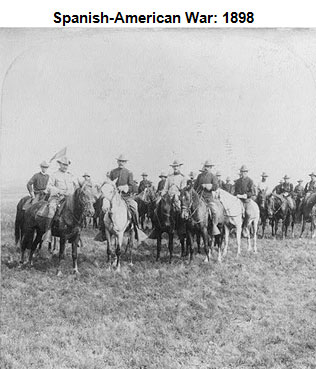
As discussed in the previous section, a turning point is a time when an important event causes a significant change. In this section, you will learn about several wars that have caused a major change in the history of the United States.

The Spanish-American War, fought in 1898, was a war between Spain and the United States. Spain, a world leader in early exploration, had established many colonies in Latin America, the Caribbean, and the Pacific Ocean. By the end of the 19th century, Spain’s hold on its territories had loosened, and Spain was left with only the colonies of Puerto Rico, Cuba, Guam, and the Philippines.
![]() Take a look at the timeline of the events of the Spanish-American War. Scroll over each flag to see the major events of the Spanish-American War.
Take a look at the timeline of the events of the Spanish-American War. Scroll over each flag to see the major events of the Spanish-American War.
After reluctantly entering the war, the United States proved that its naval strength was superior to that of Spain. The United States defeated Spain, and after the war, the Spanish had to relinquish its possession of the Philippines, Guam, and Puerto Rico.
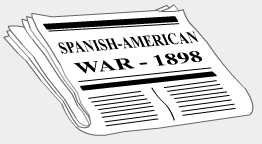
Turning Point: Winning the war with Spain meant more than just a victory for the United States. The United States expanded its boundaries and influence into Latin America, the Pacific, and the Caribbean. As a result of the United States’ military dominance during the war and its territorial acquisitions, the United States surpassed Spain as a world leader.
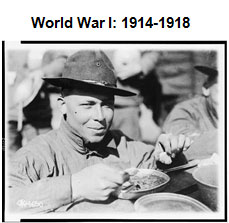
During the summer of 1914, there was growing tension among many of the countries of Europe that found themselves at the brink of war. Countries began to form a system of alliances that further divided the continent. The assassination of the Archduke Franz Ferdinand, the heir to the Austro-Hungarian Empire, sparked the beginning of the war in June 1914. When the war broke out, there were two sides, the Central Powers (Germany and Austria-Hungary) and the Allied Powers (France, Great Britain, and Russia, which later withdrew from the war).
While the war was underway in Europe, the United States maintained a position of isolationism in which the country isolated itself from war and stayed out of the affairs of any of the nations involved in the conflict. This position worked until the Germans sank the Lusitania, a British passenger ship, killing American passengers. Americans were angered but did not immediately become involved in the war. The United States was finally pushed into war after the discovery of the Zimmerman Note.
The Zimmerman Telegram (Note)
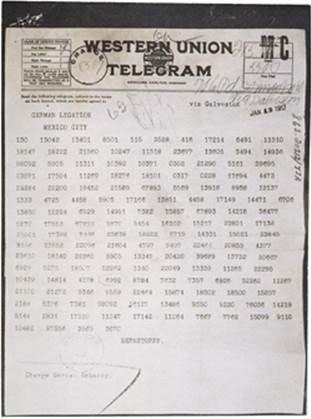
Source: Zimmerman Telegram as Received by the German Ambassador to Mexico, 1/19/1917, National Archives
The Zimmerman Note was a telegram (pictured above) that was sent from Germany to Mexico. The British intercepted the message from Germany and discovered that Germany invited Mexico to go to war against the United States. Americans saw this as a threat and declared war against Germany in April 1917. The United States joined World War I on the side of the Allied Powers and changed the tide of the war. The Allies struggled to hold off the Central Powers in a two-front war until American troops arrived. The Allied Powers would go on to win the war with the help of the U.S. military.
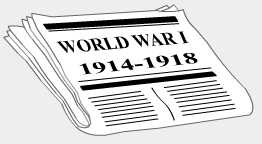
Turning Point: The United States’ entry into World War I proved that the United States was a military leader and a world power.
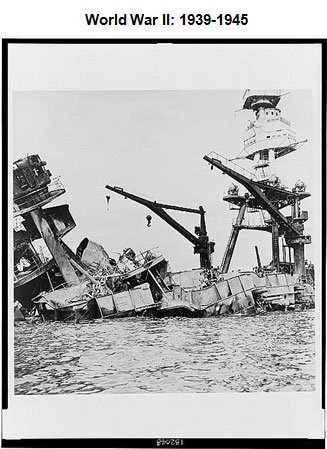
Similar to the previous wars discussed in this section, the United States was reluctant to enter World War II. This war began as a result of the failure of the Treaty of Versailles, the peace treaty that ended World War I.
World War II was initially fought in Europe and involved only European countries. Adolf Hitler led Germany and Benito Mussolini led Italy as the two superpowers that formed the Axis Powers. After occupying most of Europe, Germany invaded Poland in 1939, which prompted the leaders of France and Great Britain to declare war on Germany. Europe was engulfed in a war that involved nearly the entire continent, and Germany was working on occupying the remaining countries.
At the same time that Germany was attacking Europe, Japan was beginning to attack countries in Asia, expanding its power in the region. In an effort to curb Japan’s aggressive expansion in Asia, the United States, which had remained neutral throughout the war, entered into negotiations with Japan.
Japan grew tired of negotiating with the United States. In a surprise attack, Japan bombed the United States at Pearl Harbor in Hawaii. On December 8, 1941, the United States joined World War II on the side of the Allied Powers along with Great Britain, France, and Russia. Japan joined the Axis Powers.
Upon its entry, the United States devoted all of its resources, human and material, to fighting the war. This conversion to a wartime economy brought the United States out of an economic depression. The U.S. military joined its allies in two locations: the Pacific Theater against Japan and the European Theater against Germany.
In the Pacific Theater, the United States and its powerful naval forces dominated the Japanese forces. In a move to avoid invading Japan and to save thousands of lives, President Harry Truman decided to use the atomic bomb on two main Japanese cities, Hiroshima and Nagasaki. The death and destruction caused by the bombings forced Japan to surrender in August 1945.
In the European Theater, the United States invaded Europe on D-Day, June 6, 1944, in a successful campaign called “Operation Overlord.” This successful invasion set the tone for the contribution of the U.S. troops. The German forces slowly began to deteriorate, and the Germans eventually surrendered in September 1945.
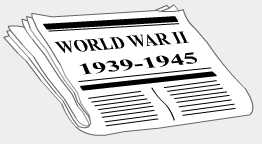
Turning Point: The end of World War II caused the beginning of a new era of conflict, the Cold War. As allies brokered a post-war agreement, some found themselves as enemies in a bitter battle of ideologies and prepared for another war.
Sources of images used in this section, as they appear, top to bottom: